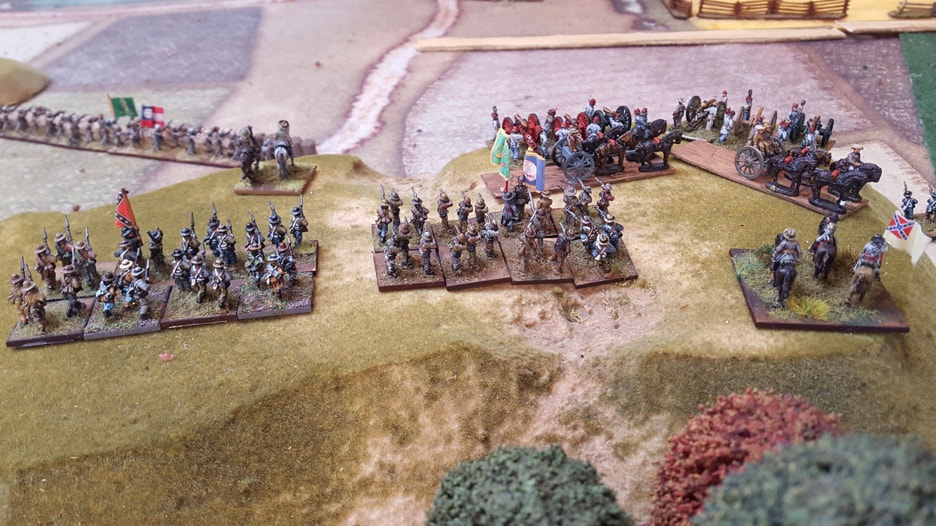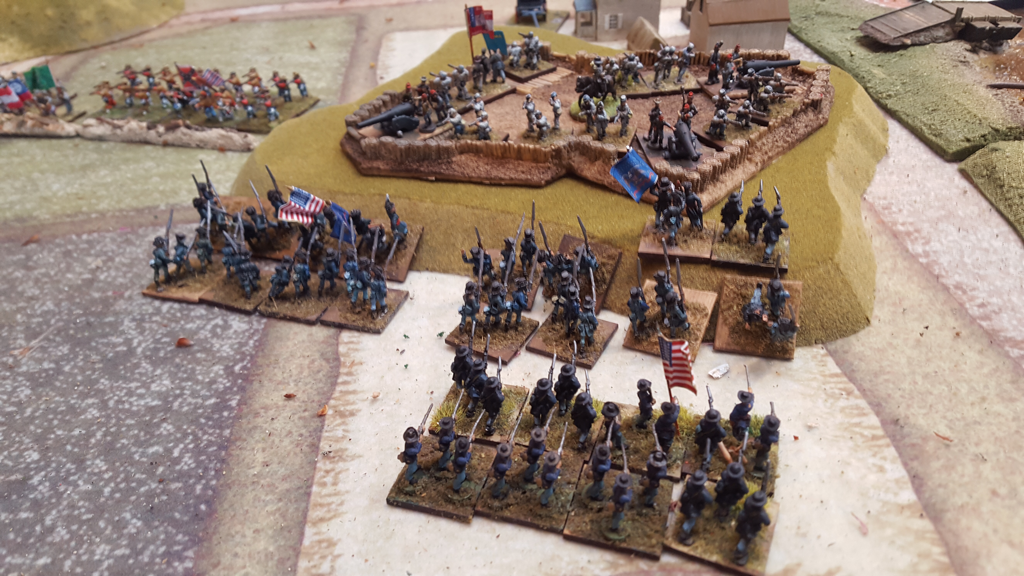|
While in Devon last weekend I played a game laid on by Keith, my ancient and constant wargaming opponent. He had set up a scenario for Longstreet, adapted from Warlord Games’ Glory, Hallelujah! ACW supplement, in which a Federal force of two divisions has the job of capturing a Confederate-held riverside fort, itself supported by two field brigades. I think the original scenario is called Wright’s Farm. I took the Confederates and Keith the Federals. Both of our break points, based on my outnumbered force, was 44. If Keith captured the fort, it would be worth an additional die towards rolling for my demoralisation. Keith had the option of bringing a steamer down stream to bombard the fort, although this would bring it in range of my heavy guns. Keith set up on a chain of hills overlooking the fort. I put a regiment in garrison with four heavy rifled artillery pieces in the fort on my left. The valley between the fort and the hill in my centre was filled with an entrenched regiment, then I placed one brigade in the centre and the last on high ground on my right. The frontages of our two forces were therefore about equal at the start, although Keith was deployed in more depth. In summary, the game began with Keith marching out all along his line, with a little more pace on his two flanks. His right wing assaulted the fort three times and each attack was repulsed. On his left, shortly before his line came within small arms range, I withdrew my right hand brigade and started moving them to reinforce my centre and left. I wanted the Union left flank to land its punch into mid-air and then be too far away to affect the fight for the fort. This nearly worked perfectly except Keith played a Confusion card on my rearmost regiment, which allowed him to catch and maul it. Apart from this I was pleased with the timing and execution of the withdrawal. In the centre, Keith’s initial intention had been to screen but he attacked four of my regiments at the same time as his last assault on the fort. This turn increased my losses but my line held. Shortly after, a very successful round of Confederate shooting pushed Keith over his morale limit and the game ended. The steamer never arrived to bombard the Confederate shore. This was a tense and fun game. I didn’t fancy my chances at the start since I was so heavily outnumbered but the fort was tough and I was able to inflict a lot of damage on the assaulting troops as they closed. As ever, the Longstreet cards dealt some memorable incidents that few other rule sets can allow unless they have an umpire. Foremost was the catching of my retreating right wing, which I would not have allowed to happen without the interference of an Interrupt card. Keith also inflicted a ‘couldn’t hit an elephant’ card (ie general hit by enemy fire) that removed 5 cards from my hand in one terrible turn. The Longstreet cards are a finely balanced device, keeping uncertainty high but never overwhelming the mechanics with too much arbitrary luck. Throughout a game, you still play your opponent rather than the system. I have said this before and it is still true: Longstreet is my favourite rules set, for any period. These simple, taut and flavour-filled rules are just masterful. Longstreet is quite hard to come by these days, at least in the UK. That said, the introductory rules and cards are still available to download for free on the Honour Games website. The combat rules are only slightly less comprehensive than the main rules, although they lack the campaign system. But the free rules and cards are still a great starting point. The figures were from Keith’s 15/18mm collection, mostly by Peter Pig. Buildings by Timecast and cloth by Cigar Box Battles.
0 Comments
Leave a Reply. |
Archives
November 2023
Categories
All
|





 RSS Feed
RSS Feed